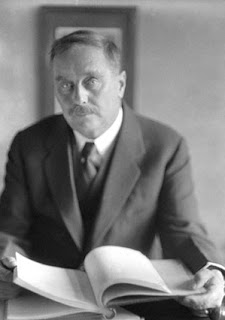From: "The Idea of a League of Nations," Atlantic Magazine, January 1919
In four brief years, therefore, Europe was compelled to develop a warfare monstrously out of proportion to any conceivable good which the completest victory could possibly achieve for either side.
 |
| German Photo of Captured British Tank |
We may take as a typical instance of this logical and necessary exaggeration which warfare has undergone the case of the 'tank.' The idea of a land ironclad was an old and very obvious one, which had been disliked and resisted by military people for many years. The substantial basis of the European armies of 1914 was still a comparatively inexpensive infantry, assisted by machine guns and field-guns and cavalry. By 1918 the infantry line is sustained by enormous batteries of guns of every calibre, firing away an incredible wealth of ammunition; its structure includes the most complicated system of machine-gun nests and strong posts conceivable, and every important advance is preceded by lines of aeroplanes and sustained by fleets of these new and still developing weapons, the tanks. Every battle sees scores of these latter monsters put out of action.
Now, even the primitive tank of 1917 costs, quite apart from the very high running expenses, something between seven and ten thousand pounds. At that stage it was still an expedient on trial and in the rough. But its obvious corollary in movable big-gun forts with ammunition tenders—forts which will probably be made in parts and built up near to the point of use, however costly they may be—is practically dictated if war is to continue. So too is a production of light and swift types of tank that will serve many of the purposes of cavalry.
 |
| H.G. Wells |
If war is to continue as a human possibility, this elaboration of the tank in scale and species follows inevitably. A mere peace of the old type is likely to accelerate rather than check this elaboration. Only a peace that will abolish the probability of war from human affairs can release the nations from the manifest necessity of cultivating the tank, multiplying the tank, and maintaining a great manufacture and store of tanks, over and above all the other belligerent plants which they had to keep going before 1914. And these tanks will supersede nothing—unless perhaps, to a certain extent, cavalry. The tank, growing greater and greater and more numerous and various, is manifestly, therefore, one new burden—one of many new burdens—which must rest upon the shoulders of mankind henceforth, until the prospect of war can be shut off from international affairs. It is foolish to ignore these grimly budding possibilities of the tank. There they are, and they cannot be avoided if war is to go on.
But the tank is only one of quite a multitude of developments, which are bound to be followed up if the modern war-process continues. There is no help for it. In every direction there is the same story to be told—if war is still to be contemplated as a possibility—of an unavoidable elaboration of the means of war beyond the scale of any conceivable war end.

Very prescient article given the advances in tank development, aircraft development, and radar
ReplyDelete"The idea of a land ironclad was an old and very obvious one" - now that's a futurist talking!
ReplyDeleteHe may have been thinking of Leonardo da Vinci's sketch of something like the concept of a tank.
DeleteMaybe so. Or he was showing off, having published "The Land Ironclads" way back in 1903.
Delete